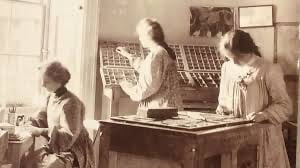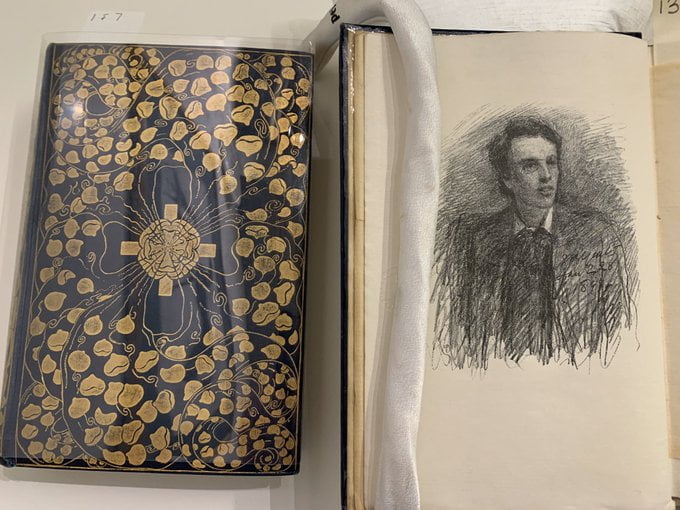One of the things I most admire about WB Yeats is the care he took with his books, not just in their writing —- he was an avid reviser and improver -—but in their design and presentation. And in how he represented his own ideas and intentions to potential readers through pro- motional efforts and reviews.
All this, by definition of The Alliance of Independent Authors (ALLi), makes him an “indie author”: a writer who takes control, who acts as creative director of the entire book project, from concept to completion, through publication and beyond.
Secret Rose
Back in 1890s, when WB Yeats was planning his book of talismanic short stories, he intended the sequence to finish with a triptych of visionary moments in a contemporary setting, held together by a single narrator.
These final three stories were to presage the end of the Christian era and the birth of a new order.
This mix of old and new, pagan and Christian, is the point towards which the other stories in the book have been aimed, but Yeats’s publisher, Arthur Henry Bullen, took fright at all this Celtic and Gaelic mysticism, telling the writer he was making himself too “heterodox.”
He insisted on the removal of the final two stories as a condition of publication, so the book ended with “Rosa Alchemica”, and the narrator pressing the rosary beads to his heart, instead.
By leaving the final two twists of the gyre out of The Secret Rose, the chronological and thematic structure the author so carefully constructed was broken and the meaning of his book eviscerated.
Bullen later privately published the two stories in a separate slim volume but it’s hard to imagine that was much consolation to Yeats.
The Power of Self-Publishing
In 2015, it was the 150th  anniversary of Yeats’s birth. I was completing a novel based on his life that I had been researching and writing for many years. I wanted to pay tribute to the master, the writer who has meant more to me, in so many ways, than any other.
anniversary of Yeats’s birth. I was completing a novel based on his life that I had been researching and writing for many years. I wanted to pay tribute to the master, the writer who has meant more to me, in so many ways, than any other.
A thought came to mind: that I would love to put The Secret Rose stories back together again, the way Yeats originally intended them to be read and that I would most dearly love to put them into a book with my own novel, Her Secret Rose, so readers could understand what was going on in his life when he wrote those stories.
The latter idea gives me a real frisson. My book and Yeats’s book together, between two covers. The audacity! But, hey, it was 2015. I was an indie author. Nobody can stop me as Bullen had stopped Yeats.
And what more fitting tribute could I make? I was delighted to have had the tools and technology that allowed me to create this very special edition book.
But Which Version Was It?
WB Yeats was a determined reviser of all his work and his vision for The Secret Rose, where he had to unite so many different occult preoccupations and traditions, had him revising right up to a frenzy of last-minute proof corrections. And after publication, the rewriting went on.
The various versions of the stories are outlined in the much-admired variorum edition (1981), which follows the standard editorial convention of choosing the author’s last revised version as the definitive text.
I took a different approach. My intention was to be as true as possible to the artistic intentions of the author, as he compiled that first edition of 1897.
At first I leaned towards reproducing the stories as originally written but then I read what Yeats said in 1925: “They were, as first published, written in that artificial, elaborate English so many of us played with in the ‘nineties, and I had come to hate them. I asked Lady Gregory’s help [and] we worked together … she now suggesting a new phrase or thought, and now I, till all had been put into that simple English she had learned from her Galway countrymen, and the thought had come closer to the life of the people.”
I quite like the languorous, druggy, Pateresque prose of the 1890s and found it transported me to the otherworld more effectively than Lady Gregory’s “Kiltartanese” but I wasn’t going to issue the work in language Yeats had come to hate, so I used the Gregory-revised versions of the texts.
I restored the two stories axed by Bullen but also removed two of the weaker tales that Yeats later pulled, and substituted the later story, “Red Hanrahan,” for the 1890s version “The Book of the Great Dhoul and Hanrahan the Red”.
In short, I cut up different versions of the stories and put them all back together in the combination that I think would have put a smile on Yeats’s 33-year- old face, when he was still the troubled, controlling and confused genius depicted in the novel, who had not yet undergone the life-changing experiences with Maud Gonne that book revolves around.
Cuala Press

The Cuala Press was set up in 1908 by Elizabeth Yeats, WB's sister, (known as Lolly) with his support.
Originally Dun Emer Press, from 1908 until the late 1940s it functioned as Cuala Press, publicising not just both of the Yeats brothers but also his friend and collaborator, Lady Gregory and others.
Yeats was artistic director and effectively treated the press as his own publisher. He acted as editor and artistic directors, occasioning many arguments with his sister.
He provided his poems for use in greeting cards and prints, and the press published several first editions of his works, like “The Wild Swans at Coole” and “Reveries Over Childhood and Youth,” as well as publishing pieces by other notable authors such as Lady Gregory, J.M. Synge, A.E., Katharine Tynan, Lady Glenavy, and Pamela Colman Smith
In 1902, inspired by a proposal from their friend Evelyn Gleeson, the sisters embarked on an Irish craft business that exclusively hired women, resulting in the establishment of Dun Emer in Dundrum. This venture featured an embroidery division led by Lily and a printing press overseen by Lolly, with Evelyn providing the necessary financial backing. Their inaugural publication was “In the Seven Woods,” a collection of William's early poetry. Despite the business's financial success, disagreements arose between Lolly, Lily, and Evelyn.
By 1909, the sisters decided to operate independently, creating the Cuala imprint. Under this new label, Lolly continued to publish her brother's works, including “Poetry and Ireland” and “Responsibilities”.
Lolly was a prominent figure in the book printing industry, leading the presses at both Dún Emer and Cuala Industries. She was globally recognized for her expertise in book printing.
Her ambition was to rejuvenate the traditional craft of book printing in Ireland. Her printing repertoire extended beyond books, encompassing greeting cards, hand-coloured prints, pamphlets, and a series of monthly magazines called broadsides.
Her brother showed little gratitude. He and Lolly did not get on and later, in his autobiography, he gave the impression that he had only one rather shadowy sister (Lily) on the fringes of his life, though Lolly had contributed so much to his work. He regularly lamented the necessity of finding books “to feed my sister's hungry press”.
Yet Cuala Press offered him a unique advantage as a writer: the freedom typically associated with self-publishing without the burden of its responsibilities, thanks to his sister.
He could choose what to publish and how it should be presented without the constraints often imposed by commercial publishers. Lolly ensured that his works were presented in a way that aligned with his aesthetic and thematic preferences.
Cuala Press was known for its high-quality, artisanal approach to book printing. This meant that Yeats's works were not only published but were crafted with a level of care and attention to detail that complemented and enhanced his literary reputation.
